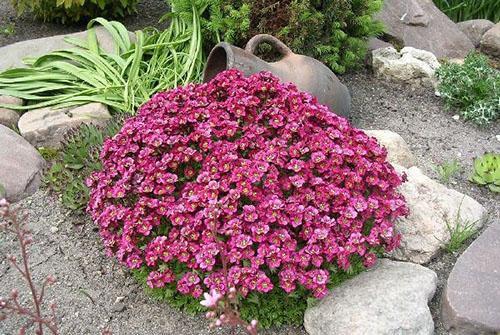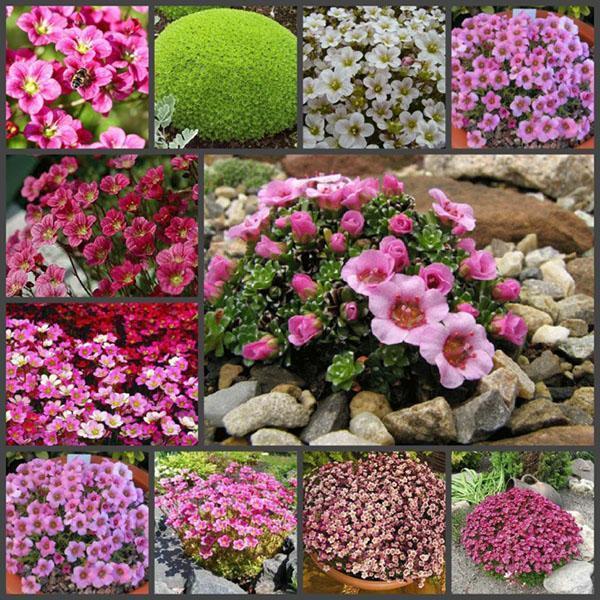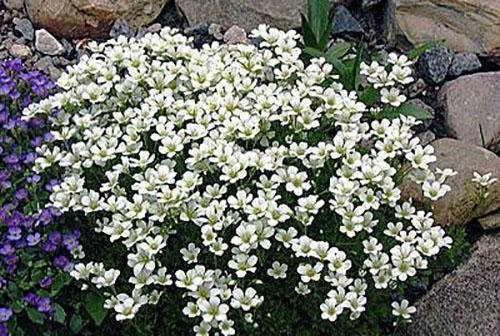What do you know about planting and caring for saxifrage outdoors?
 The name of this plant speaks for itself, dense foliage and bright buds growing in hard-to-reach places, among stones, in cracks and on slopes. Correct planting and care of saxifrage in the open field allows you to decorate any landscape design with it and transform your garden composition.
The name of this plant speaks for itself, dense foliage and bright buds growing in hard-to-reach places, among stones, in cracks and on slopes. Correct planting and care of saxifrage in the open field allows you to decorate any landscape design with it and transform your garden composition.
Saxifrage - flowers on stones

Sod and Arends saxifrage are two of the most popular garden varieties.
The wonderful soddy saxifrage grows in rosettes, densely covering the stony ground, its flowers are small and light, it fades quickly.
Arends' saxifrage is like a luscious green carpet spreading between stones, the color of its buds varies from white to deep purple, the flowering period is early summer.
A photo of a saxifrage in an open field demonstrates different varieties and types of this plant:
- Manchu;

- reed;

- wicker;
- round-leaved;

- paniculate;

- shady;

- others.
Among their distinctive features are the type and shape of the stem, the size and quality of the leaves, the shades and type of flowers, the requirements for environmental conditions and care.
Growing technology and care
 The unpretentiousness of the saxifrage is obvious. The natural growing environment has taught her to a dry climate and an abundance of sunlight. Its root system is designed in such a way that it is able to hold and nourish the plant in the most extreme conditions - in the sun among stones, without water in crevices and in an upright position on slopes. Planting and caring for perennial saxifrage in the open field should be similar to the natural conditions of its life. The saxifrage is resistant to drought and heat, it is not afraid of low temperatures and soil freezing. Softer environmental conditions can destroy her.
The unpretentiousness of the saxifrage is obvious. The natural growing environment has taught her to a dry climate and an abundance of sunlight. Its root system is designed in such a way that it is able to hold and nourish the plant in the most extreme conditions - in the sun among stones, without water in crevices and in an upright position on slopes. Planting and caring for perennial saxifrage in the open field should be similar to the natural conditions of its life. The saxifrage is resistant to drought and heat, it is not afraid of low temperatures and soil freezing. Softer environmental conditions can destroy her.
The more complex in structure and worse in quality the soil, the better the saxifrage will feel in it.
Open field saxifrage - seed planting and care:
- Soil selection. It will not be superfluous at all if the planting soil contains part of the peat and sand, there are inclusions of gravel and crushed stone. A prerequisite for good growth and development of saxifrage is a drainage system that does not allow liquid stagnation at the surface and roots.
- Compliance with the optimal temperature regime. Achieving a balance between light and shade for saxifrage can be achieved by staggered planting, avoiding the very tops of the compositions.
- No excess moisture. The best place to grow saxifrage is among stones and at an angle. If this cannot be achieved, then it is necessary to provide the plant with high-quality drainage to quickly remove excess moisture. Mulching is not recommended.
- Dosed top dressing.A grainy, low-fertile base is what a saxifrage needs for good growth and lush flowering. Activities in the form of rare complex dressings are all that an unpretentious perennial needs.
- When saxifrage blooms in the open field. The timing of budding in different plant varieties falls on a different period of the summer season. Blossoming usually begins in June.
Oases of different varieties of saxifrage allow you to create picturesque mountain landscapes right on your personal plot. And the best neighbors for her are conifers and shrubs.
Saxifrage - breeding methods
 After flowering, the ground part of the plant should be cut off. This procedure stimulates the appearance of new leaves. Winter is not terrible for saxifrage; it easily tolerates snowfalls and frosts. It is recommended to cover the plant from spring frosts.
After flowering, the ground part of the plant should be cut off. This procedure stimulates the appearance of new leaves. Winter is not terrible for saxifrage; it easily tolerates snowfalls and frosts. It is recommended to cover the plant from spring frosts.
When to plant saxifrage outdoors:
- Seeds. The average germination rate of saxifrage seeds is quite high - within 90%. Seed germination occurs in 6-7 days. Seedlings are grown from seeds in pots, boxes or containers.
- Seedlings. To obtain seedlings, saxifrage seeds are sown in a pot. Seedlings are dived and planted in separate pots. Seedlings are planted in open ground in late May - early June.
- Sockets. At the end of flowering, you can separate and plant the rosettes from the main bush, rooting them in the soil, protected from the scorching sun. In spring, gardeners boldly plant new plants in open ground.
 The saxifrage takes its rightful place in landscape design... Among its obvious advantages are spectacular appearance, unpretentiousness to natural conditions, the ability to coexist with many flowering plants, low-growing trees and shrubs. Blooming saxifrage will revive rockeries and become a highlight in the rock garden. It perfectly complements the mountain composition, without it it is impossible to imagine a man-made rocky landscape.
The saxifrage takes its rightful place in landscape design... Among its obvious advantages are spectacular appearance, unpretentiousness to natural conditions, the ability to coexist with many flowering plants, low-growing trees and shrubs. Blooming saxifrage will revive rockeries and become a highlight in the rock garden. It perfectly complements the mountain composition, without it it is impossible to imagine a man-made rocky landscape.